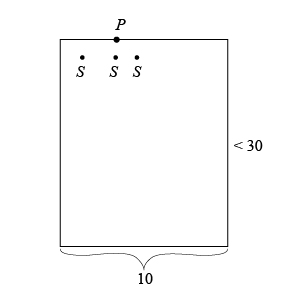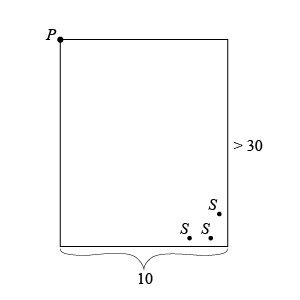| Quantity A | $\;\;\;\;\;\;\;\;\;\;\;\;\;\;\;\;\;\;\;\;\;\;\;\;\;\;\;\;\;\;\;$ | Quantity B |
| $\;\;\;\;\;\;\;\;\;\;\;\;\;\;\;\;\;\;\;\;\;\;\;\;\;\;\;\;\;\;\;\;\;\;\;\;\;\;\;\;\;\;\;\;\;\;\;\;\;\;\;\;\;\;\;\;\;\;\;\;\;$ | ||
| The sum of the distances from the power station to each of the substations | $\;\;\;\;\;\;\;\;\;\;\;\;\;\;\;\;\;\;\;\;\;\;\;\;\;\;\;\;\;\;\;\;\;\;\;\;\;\;\;\;\;\;\;\;\;\;\;\;\;\;\;\;\;\;\;\;\;\;\;\;\;$ | $30$ miles |
- Quantity A is greater.
- Quantity B is greater.
- The two quantities are equal.
- The relationship cannot be determined from the information given.
So, you were trying to be a good test taker and practice for the GRE with PowerPrep online. Buuuut then you had some questions about the quant section—specifically question 3 of Section 6 of Practice Test 1. Those questions testing our knowledge of Quadrilaterals can be kind of tricky, but never fear, PrepScholar has got your back!
Survey the Question
Let’s search the problem for clues as to what it will be testing, as this will help shift our minds to think about what type of math knowledge we’ll use to solve this question. Pay attention to any words that sound math-specific and anything special about what the numbers look like, and mark them on our paper.
The question references a square region, so we should expect it to test what we’ve learned about Quadrilaterals. Let’s keep what we’ve learned about this skill at the tip of our minds as we approach this question.
What Do We Know?
Let’s carefully read through the question and make a list of the things that we know.
- We have a square that is $10$ miles on each side
- A power station is located somewhere on the square’s boundary
- Three substations are located somewhere inside the square
- We want to compare the sum of the distances from the power station to the substations to the value $30$ miles
Develop a Plan
First, let’s plan to draw figures on our paper as we solve this question. Geometry questions that involve figures not shown are very amenable to solution methods where we draw our own figures within the constraints of the question.
For Quantitative Comparison questions, often times the goal is to look for the extreme values for quantities. This is particularly useful for quantities that do not have a single value. We seemingly have limitless possibilities as to where the power station and substations could be located, so let’s look for two extreme values: 1) where the sum of the distances between the power station and substations is very small and 2) where the sum of the distances between the power station and substations is very large.
Solve the Question
First, let’s try to draw a situation where the sum of the distances between the power station and substations is very small.
Let’s remember that we’re constrained by: 1) the power station MUST be on the square boundary and 2) the substations must be inside the square.

Visually, we can definitely see that it’s possible to get a value for the sum of the distances between the power station and the substations that is much less than $30$ miles. Theoretically, we could draw them adjacent to each other where the distance is just slightly greater than $0$ miles. So we’ve found one extreme value for Quantity A, which is that it must be greater than $0$ miles, but it can go down very close to $0$ miles:
Next, let’s draw a picture that maximizes the value for Quantity A:

Here, we can definitely see that it’s possible to get a value for the sum of the distances between the power station and the substations that is greater than $30$ miles. Let’s keep in mind that we don’t need to calculate the actual distances here; it’s sufficient to just show that we can get a distance between the power station and each individual substation that is greater than $10$ miles, and then the sum of the distances between the power station and all three of the substations will be greater than $30$ miles, since $3·10=30$.
Since we’ve determined that Quantity A could be less than $30$ miles and it could also be greater than $30$ miles, the correct answer is D, the relationship cannot be determined from the information given.
What Did We Learn
A great solution method for Quantitative Comparison questions is to look for extreme values for any Quantity that doesn’t have a single value. We’ll want to find both the least and greatest possible values for that quantity, then proceed with our comparison.
Want more expert GRE prep? Sign up for the five-day free trial of our PrepScholar GRE Online Prep Program to access your personalized study plan with 90 interactive lessons and over 1600 GRE questions.
Have questions? Leave a comment or send us an email at [email protected].

